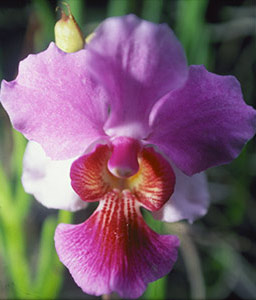Plant Systematics : Monocots
Monocots belong to the Class Liliopsida. The monocots are characterized by a single cotyledon in the embryo.
Among the monocots include one of the most common and ubiquitous of all plants, grass. Grasses are varied and important agriculturally and economically. While we are all familiar with the grass making up our lawns and fields, some may be surprised to know that corn is also a type of grass. The grasses with round stems belong to the family Poaceae. The sedges that grow in wet areas and ditches have three-cornered stems, and belong to the family Cyperaceae.

A tropical orchid with bright red coloration guiding the pollinator to the nectar.
Not all monocots have simple, tiny flowers like the grasses. In fact, some of the most diverse and complicated of all flowers belong to the monocots, namely the orchids. Orchids are famous for the elaborate mechanisms that have evolved in these flowers to facilitate pollination. Each of the thousands of different species of orchid bears a design specific to its preferred pollinator, which often involves several carefully orchestrated steps before pollen is deposited on the stigma.
The huge, dramatic flowers of lilies are another example of the showy monocots. Many wildflowers in our area, such as the Adder's Tongue and Trillium, belong to the family Liliaceae. The tropical looking Jack-in-the-Pulpit flower is another monocot growing wild in the woods of Southern Indiana, in the family Araceae. Commonly cultivated monocots include Daffodils, Tulips, Lilies, Hyacinths, Cannas, Calla Lilies, and Iris.




